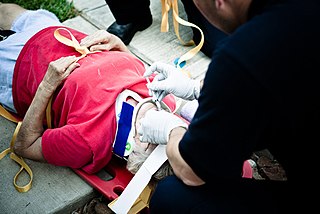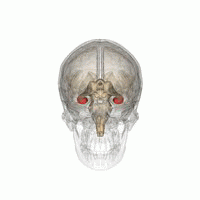Working memory is a cognitive system with a limited capacity that can hold information temporarily. It is important for reasoning and the guidance of decision-making and behavior. Working memory is often used synonymously with short-term memory, but some theorists consider the two forms of memory distinct, assuming that working memory allows for the manipulation of stored information, whereas short-term memory only refers to the short-term storage of information. Working memory is a theoretical concept central to cognitive psychology, neuropsychology, and neuroscience.

Traffic psychology is a discipline of psychology that studies the relationship between psychological processes and the behavior of road users. In general, traffic psychology aims to apply theoretical aspects of psychology in order to improve traffic mobility by helping to develop and apply crash countermeasures, as well as by guiding desired behaviors through education and the motivation of road users.

Risk compensation is a theory which suggests that people typically adjust their behavior in response to perceived levels of risk, becoming more careful where they sense greater risk and less careful if they feel more protected. Although usually small in comparison to the fundamental benefits of safety interventions, it may result in a lower net benefit than expected or even higher risks.
A microsleep (MS) is a sudden temporary episode of sleep or drowsiness which may last for a few seconds or up to several seconds where an individual fails to respond to some arbitrary sensory input and becomes unconscious. MSs occur when an individual loses and regains awareness after a brief lapse in consciousness, often without warning, or when there are sudden shifts between states of wakefulness and sleep. In behavioural terms, MSs may manifest as droopy eyes, slow eyelid-closure, and head nodding. In electrical terms, microsleeps are often classified as a shift in electroencephalography (EEG) during which 4–7 Hz activity replaces the waking 8–13 Hz background rhythm.

Driving simulators are used for entertainment as well as in training of driver's education courses taught in educational institutions and private businesses. They are also used for research purposes in the area of human factors and medical research, to monitor driver behavior, performance, and attention and in the car industry to design and evaluate new vehicles or new advanced driver assistance systems.
The term workload can refer to a number of different yet related entities.
David J. Heeger is an American professor of psychology and neural science at New York University, and an entrepreneur. His academic research spans a cross-section of engineering, psychology, and neuroscience. He is also Chief Scientific Officer of Statespace Labs, and Chief Scientific Officer and co-founder of Epistemic AI.
Brain training is a program of regular activities purported to maintain or improve one's cognitive abilities. The phrase “cognitive ability” usually refers to components of fluid intelligence such as executive function and working memory. Cognitive training reflects a hypothesis that cognitive abilities can be maintained or improved by exercising the brain, analogous to the way physical fitness is improved by exercising the body. Cognitive training activities can take place in numerous modalities such as cardiovascular fitness training, playing online games or completing cognitive tasks in alignment with a training regimen, playing video games that require visuospatial reasoning, and engaging in novel activities such as dance, art, and music.

A traffic collision, also called a motor vehicle collision, car accident or car crash, occurs when a vehicle collides with another vehicle, pedestrian, animal, road debris, or other stationary obstruction, such as a tree, pole or building. Traffic collisions often result in injury, disability, death, and property damage as well as financial costs to both society and the individuals involved. Road transport is the most dangerous situation people deal with on a daily basis, but casualty figures from such incidents attract less media attention than other, less frequent types of tragedy.

It has been estimated that over 20% of adults suffer from some form of sleep deprivation. Insomnia and sleep deprivation are common symptoms of depression, and can be an indication of other mental disorders. The consequences of not getting enough sleep could have dire results; not only to the health, cognition, energy level and the mood of the individual, but also to those around them as sleep deprivation increases the risk of human-error related accidents, especially with vigilance-based tasks involving technology.

Inhibitory control, also known as response inhibition, is a cognitive process – and, more specifically, an executive function – that permits an individual to inhibit their impulses and natural, habitual, or dominant behavioral responses to stimuli in order to select a more appropriate behavior that is consistent with completing their goals. Self-control is an important aspect of inhibitory control. For example, successfully suppressing the natural behavioral response to eat cake when one is craving it while dieting requires the use of inhibitory control.
The correlation between old age and driving has been a notable topic for many years. In 2018, there were over 45 million licensed drivers in the United States over the age of 65—a 60% increase from 2000. Driving is said to help older adults stay mobile and independent, but as their age increases the risk of potentially injuring themselves or others significantly increases as well. In 2019, drivers 65 years and older accounted for 8,760 motor vehicle traffic deaths, and 205,691 non-fatal accidents. Due to their physical frailty, older drivers are more likely to be injured in an accident and more likely to die of that injury. When frailty is accounted for and older drivers are compared to younger persons driving the same amount the over-representation disappears. According to the Insurance Institute for Highway Safety, a senior citizen is more likely than a younger driver to be at fault in an accident in which they are involved. The most common violations include: failure to obey traffic signals, unsafe turns and passing, and failure to yield.

Distracted driving is the act of driving while engaging in other activities which distract the driver's attention away from the road. Distractions are shown to compromise the safety of the driver, passengers, pedestrians, and people in other vehicles.

Geriatric trauma refers to a traumatic injury that occurs to an elderly person. People around the world are living longer than ever. In developed and underdeveloped countries, the pace of population aging is increasing. By 2050, the world's population aged 60 years and older is expected to total 2 billion, up from 900 million in 2015. While this trend presents opportunities for productivity and additional experiences, it also comes with its own set of challenges for health systems. More so than ever, elderly populations are presenting to the Emergency Department following traumatic injury. In addition, given advances in the management of chronic illnesses, more elderly adults are living active lifestyles and are at risk of traumatic injury. In the United States, this population accounts for 14% of all traumatic injuries, of which a majority are just mainly from falls.

Drunk driving is the act of driving under the influence of alcohol. A small increase in the blood alcohol content increases the relative risk of a motor vehicle crash.

Memory improvement is the act of enhancing one's memory. Memory deficits, age-related memory loss, and people's want to improve their own memory have led to research on how to best help people to improve their memory. Research has also worked to determine what factors influence memory and cognition. Many different techniques to improve memory have been found, including cognitive training, psychopharmacology, diet, stress management, and exercise. Each technique has the ability to influence memory in different ways. Neuroimaging has also provided neurobiological evidence supporting holistic ways in which one can improve memory.

Attentional control refers to an individual's capacity to choose what they pay attention to and what they ignore. It is also known as endogenous attention or executive attention. In lay terms, attentional control can be described as an individual's ability to concentrate. Primarily mediated by the frontal areas of the brain including the anterior cingulate cortex, attentional control is thought to be closely related to other executive functions such as working memory.

The neurobiological effects of physical exercise are numerous and involve a wide range of interrelated effects on brain structure, brain function, and cognition. A large body of research in humans has demonstrated that consistent aerobic exercise induces persistent improvements in certain cognitive functions, healthy alterations in gene expression in the brain, and beneficial forms of neuroplasticity and behavioral plasticity; some of these long-term effects include: increased neuron growth, increased neurological activity, improved stress coping, enhanced cognitive control of behavior, improved declarative, spatial, and working memory, and structural and functional improvements in brain structures and pathways associated with cognitive control and memory. The effects of exercise on cognition have important implications for improving academic performance in children and college students, improving adult productivity, preserving cognitive function in old age, preventing or treating certain neurological disorders, and improving overall quality of life.
Human performance modeling (HPM) is a method of quantifying human behavior, cognition, and processes. It is a tool used by human factors researchers and practitioners for both the analysis of human function and for the development of systems designed for optimal user experience and interaction. It is a complementary approach to other usability testing methods for evaluating the impact of interface features on operator performance.
Postural control refers to the maintenance of body posture in space. Central nervous system interprets the sensory inputs to produce motor output to maintain upright posture.









